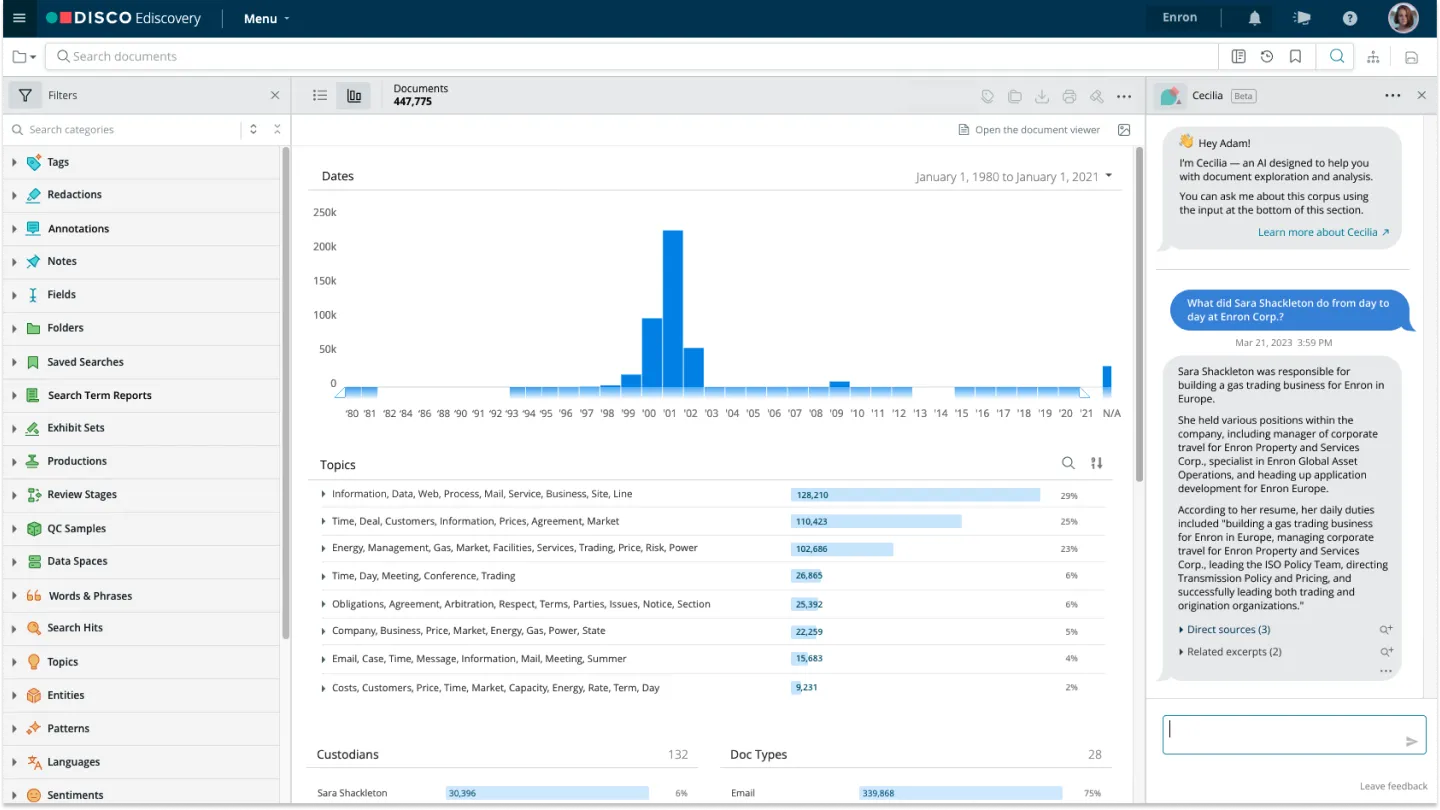⚡️ 1-Minute DISCO Download
The frameworks governing electronically stored information (ESI) are continually challenged and reshaped as technology changes how we communicate. Now, with generative AI tools moving from novelty to necessity, that evolution is accelerating.
The stakes are real. Generative AI (GenAI) systems are achieving 90%+ recall rates compared to the 70–80% recall rates achieved through technology-assisted review (TAR).
But courts have issued at least 35 standing orders requiring AI disclosure for submissions made to the court – throwing uncertainty to how courts will view GenAI in ediscovery – and, in some cases, limiting the use of generative AI since May 2023. To achieve AI’s benefits responsibly and defensively, legal professionals must navigate this new and largely yet-uncharted territory with only TAR precedent as a guide – and a great deal of uncertainty about how this precedent will carry over to GenAI use.
Related article: TAR in the Age of GenAI: The Evolution of Document Review Technology
This tension between GenAI’s potential and the evolving regulatory landscape makes updating your discovery protocols essential. In this article, I’ll look at the core components of an effective ESI protocol, the impact of GenAI, and how to update your ESI protocols to account for GenAI.
What is an ESI protocol?
In litigation, ESI includes emails, documents, chat logs, social media, phone data, and any other digital records relevant to a case.
The ESI protocol is the specific, detailed document outlining the rules and procedures for collecting, processing, and exchanging, and handling ESI during discovery, negotiated between the parties and submitted to the court. It outlines how both teams will collect, review, validate, and produce electronic records while ensuring defensibility and compliance with legal standards, defining scope, formats, search terms, validation processes, and more.
By maintaining clear, up-to-date protocol templates, legal teams can streamline negotiations, avoid disputes, and ensure defensible discovery practices. But the emergence of generative AI has introduced new variables that traditional ESI protocols weren’t designed to address.
Unlike TAR systems, which rely on supervised machine learning, generative AI tools can process natural language instructions, interpret context across varied document types, and generate explanations for their outputs.
These capabilities require protocols that are more sophisticated, transparent, and adaptable.
Core components of an effective ESI protocol
Before diving into generative AI-specific considerations, it's important to understand the essential elements that make any ESI protocol effective. These foundational components remain crucial even as we adapt to new technologies.
Scope and definitions
A strong ESI protocol starts by clearly defining what constitutes electronically stored information (ESI) within the matter. This includes not only traditional data types like emails, chat logs, and documents, but also emerging categories, including AI-generated outputs. Scope definitions should specify:
- Relevant custodians
- Applicable date ranges and geographic boundaries
- Data sources, including cloud platforms and collaborative workspaces
- Technical terms and key discovery concepts
Clear scope and definitions ensure all parties speak the same language and prevent disputes down the line.
Preservation requirements
Your protocol must establish when and how legal hold obligations begin. This section should outline:
- Notification procedures for custodians
- Responsibilities for maintaining ongoing preservation
- Processes for suspending routine deletion or alteration of potentially relevant data
- Preservation of AI-generated materials or AI-assisted review artifacts, where applicable
Addressing newer data formats, such as Slack messages and cloud-based files, is essential for comprehensive coverage.
Learn more: With DISCO Hold, you can preserve data in place with a single click while automating your legal hold process in a defensible, systemized way.
Collection methodology
How data is collected impacts both defensibility and efficiency. Your protocol should include:
- Approved collection methods (forensic imaging, targeted collections, remote capture)
- Roles and responsibilities for collections (internal teams vs. vendors)
- Chain of custody procedures
- Special considerations for encrypted, proprietary, or AI-generated data sources
This ensures transparency in how data enters the discovery process and protects against spoliation claims.
Get the guide: The Data Collection Playbook helps you standardize the basic procedures for a collection, minimizing costs and risks.
Processing and review workflow
Clearly defining review workflows reduces risk and sets consistent expectations for all parties involved. Whether using traditional review or integrating TAR and GenAI tools, your protocol should detail:
- Standard processing steps: deduplication, deNISTing, email threading, and format normalization
- Validation procedures tailored to the review method used
- Privilege and confidentiality screening processes
- Procedures for quality control and error correction
Production standards
Finally, your protocol must specify exactly how responsive documents will be produced. This includes:
- Production format (e.g., native files, TIFF with load files, PDF)
- Required metadata fields
- Delivery methods and schedules
- Redaction processes and privilege logging standards
By locking down production standards, your team minimizes rework, avoids disputes, and ensures smooth coordination with opposing counsel.
How generative AI is disrupting the ESI landscape
The introduction of generative AI tools into legal workflows is reshaping how ESI is created, managed, and reviewed. Unlike traditional discovery technologies that focus solely on classifying existing information, generative AI actively produces new content and insights:
Natural language understanding: Traditional keyword searches and TAR systems rely on statistical patterns and exact matches. Generative AI understands context, meaning, and relationships between concepts. It can identify relevant documents even when they don't contain specific keywords, navigate sarcasm and implied meaning, and recognize when the same concept is expressed in different ways.
Explanatory capabilities: Perhaps most importantly for legal discovery, generative AI can explain its reasoning. Rather than simply flagging a document as responsive or not responsive, tools like DISCO Auto Review can provide detailed explanations for their decisions and cite specific passages that support their conclusions.
Adaptive learning: Unlike TAR systems that require retraining for each new matter, generative AI can adapt to new requirements through simple natural language instructions. This means protocols can be adjusted mid-discovery without the extensive retraining that traditional systems require.
That capability brings both opportunity and risk. From a discovery standpoint, there are two key categories of AI use that legal teams must consider:
1. Using generative AI for internal or research purposes
Generative AI is commonly used today to streamline research, summarize documents for internal use, or assist with drafting non-substantive content. For example:
- Running Q&A through tools like Cecilia Q&A to drill down into case documents
- Summarizing large documents for attorney review
- Drafting internal memoranda or early-stage drafts for attorney revision
From a discovery perspective, these uses generally do not require disclosure. The AI outputs are not part of the document review or production process and do not replace human decision-making on privilege or responsiveness.
That said, firms should remain mindful of confidentiality risks. Many organizations now include policy language restricting employees from entering sensitive or privileged information into public AI tools.
Related article: How to Use Generative AI for Fact Analysis and Investigation
2. Using generative AI to fulfill discovery obligations
When generative AI is used to perform tasks directly related to discovery — such as identifying responsive documents, prioritizing review sets, or generating logs — the calculus changes.
At the time of this writing, the industry is split on disclosure. There’s a possibility going forward that courts may expect disclosure. However, as of now, Sedona Principle 6 – that the producing party is best situated to determine how to search for and produce relevant information – still applies.
Ultimately, whether or not to disclose when GenAI is used to perform tasks relating to discovery is a strategic choice to be made by the producing party. Should you choose to disclose, you’ll want to consider the following:
The caution around using GenAI to fulfill discovery obligations, especially when compared to TAR, is nuanced. TAR relies on structured workflows and statistical validation, which courts have come to recognize and accept, despite its underlying models being considered a “black box.” Generative AI, by contrast, offers greater flexibility and transparency, but its variability and potential for hallucinations can make defensible documentation more complex without rigorous oversight.
If generative AI is used in review or production, update ESI protocols to document:
- Which tool was used and for what purpose
- How outputs were validated through human review
- What steps were taken to prevent the disclosure of sensitive information to unauthorized parties
In short, generative AI is disrupting the ESI landscape by expanding what’s technologically possible — but it also introduces new layers of risk. Discovery protocols must evolve to reflect both realities: protecting client interests while embracing innovation responsibly.
Related article: What the Past Two Years of GenAI Mean for Legal’s Future
Example clauses to future-proof your protocols
If you’re updating your ESI agreement to reflect GenAI-powered workflows, clarity and defensibility matter more than ever. Here are some common clauses, adapted for use with Generative AI review, to help your protocol stand up to both scrutiny and evolving technology.
Learn more: Creating productions in DISCO
1. Search and AI review protocols
GenAI review workflows benefit from agreed protocols for transparency and defensibility. This includes specifying training samples, validation samples, and acceptable recall thresholds.
Sample language:
“The producing Party may use Generative AI (“GenAI”) document review workflow. The Parties agree that a target recall rate of no less than 75% is required to consider the review complete. The Parties further agree to disclose the statistical validation methodology used, as well as the numerical results from the validation methodology leading to the recall calculation.”
Get the mini guide: How to Set Up and QC Your First GenAI-Powered Document Review
Related: 10 Tips for ESI Agreements to Manage Discovery Costs
2. Validation and quality control standards
GenAI workflows rely on statistical validation. Ideally, the agreement should spell out exactly how this is handled.
Sample language:
“The producing Party shall conduct validation testing using statistical sampling methodologies such that the minimum recall level meets or exceeds 75% with the requisite error margin incorporated into the result.”
Additional reading: How AI Helps Solve The Precision and Recall Gap
3. Disclose generative AI
The question of whether to disclose generative AI use in discovery is yet unsettled. It appears clear that its use does not require disclosure when used for internal research and analysis. However, when using generative AI to identify documents for production, it’s unclear whether its use needs to be disclosed. Given that there is no consensus on TAR disclosure after a decade of TAR use, it seems unlikely that we’ll reach a consensus on generative AI disclosure soon, if at all.
Nonetheless, a robust ESI protocol drafting process should prepare for instances when the parties choose to disclose generative AI use for production.
Sample language:
“A Party may use keyword searching or other search methodology such as Technology Assisted Review (“TAR”) or Generative AI (“GenAI”) to identify ESI that is reasonably likely to have discoverable information regarding the subject matter of this Litigation. If any Party chooses to use keyword searching or other search methodologies to identify potentially relevant ESI, that Party shall offer to meet and confer regarding the search terms or other search methodology to be used, and the sources of ESI to be searched.”
Learn more: Ediscovery 101: Guide to Ediscovery Rules and Best Practices
Ongoing considerations and best practices for ESI protocols
Some standard best practices for ESI protocols aren’t affected by the introduction of GenAI, but are still key considerations, including:
Define ESI scope to set clear expectations
Your ESI agreement should define exactly what’s included in discovery, including sources, file types, and formats.
Sample language:
“The parties agree that ‘Electronically Stored Information’ (ESI) includes all electronic communications, documents, and files created, stored, or maintained by or for any party, including but not limited to email, word processing files, spreadsheets, databases, and collaboration platform content.”
Related article: 10 Tips for ESI Agreements to Manage Discovery Costs
Standardize production formats
Different tools handle different formats better. Agreeing on production standards up front avoids headaches later, especially when dealing with image-based productions for Bates stamping and redactions.
Sample language:
“ESI shall be produced as single-page Group IV TIFF images with corresponding load files. The load files must contain document-level extracted text and full metadata, including but not limited to file path, custodian, date created, and hash values. Files not easily converted to an image format (e.g., spreadsheets, databases, audiovisual files) shall be produced in their native format.”
Metadata preservation requirements
Preserving key metadata is non-negotiable, particularly for auditability and compliance.
Sample language:
“The producing Party shall preserve and produce all metadata associated with ESI and agree to produce all metadata listed in Appendix A of this ESI protocol.”
Learn more: How to Plan and Execute Defensible Collections
Privilege and clawback provisions
Even with a rigorous process to identify and withhold privileged documents, standard clawback language protects both parties.
Sample language:
“In the event that privileged or protected information is inadvertently produced, the producing Party may notify the receiving Party, who shall promptly return, sequester, or destroy the specified information. Such production shall not constitute a waiver under Federal Rules.”
Modifications and meet-and-confer clause
Agreements need room to flex as cases evolve.
Sample language:
“Any practice or procedure set forth herein may be modified by written agreement of the Parties. If a Party believes modification is necessary, both Parties agree to meet and confer in good faith.”
Need help navigating complex cases? Learn more about our end-to-end ediscovery services.
The value of adopting GenAI protocols for ESI
While generative AI introduces new considerations, it also brings significant advantages in terms of speed, accuracy, and review efficiency. Firms that ignore it risk falling behind, both operationally and competitively.
Here are just a few of the advantages of proactively integrating generative AI into your ESI strategy.
Operational efficiency
Manual review or TAR alone, without GenAI assistance, may no longer be the most efficient or cost-effective option. Teams sticking with outdated workflows could spend more time and money than necessary while delivering slower results.
DISCO, for example, consistently delivers:
- 87% faster fact investigation using Cecilia Q&A compared to traditional workflows, allowing teams to surface key evidence and build case strategy in a fraction of the time.
- First-pass doc review speeds of up to 32,000 docs per hour, with precision and recall rates well above the industry standards.
- 9-second document summaries, accelerating the understanding of case documents and reducing discovery and review times.
Competitive advantage
As GenAI adoption increases across the legal industry, clients and stakeholders may begin expecting AI-driven efficiency. Firms without updated protocols risk looking behind the curve.
More than half of corporate legal clients (59%) want their outside law firms to use GenAI, and 71% don’t know whether their firms use GenAI tools in their work, according to Thomson Reuters. As corporate legal departments become more AI-aware, maintaining a documented, GenAI-ready ESI protocol will likely become a client expectation.
Note: It won’t be long before clients request a frank conversation about how their firm utilizes generative AI to deliver better results and return on investment. Watch our on-demand webinar, Bridging the AI Gap, for tips on how to lead the AI conversation with clients.
Lower discovery costs
Manual review is resource-intensive. Review constitutes just over half of total ediscovery spending, and expenditures are projected to grow to approximately $13.05 billion by 2029. While it does need to be validated, generative AI significantly reduces document review volume and expedites responsiveness determinations.
Ongoing compliance and transparency
Courts increasingly suggest that the parties disclose if and how AI is used. Without a GenAI protocol built into your ESI review protocols, your teams must scramble to explain processes retroactively.
Simply by updating your protocol now, your team stays ahead of evolving judicial expectations, rather than reacting to them case by case. And protocols that include the ethical and defensible use of AI today will be easier to adapt to as technology changes.
Better client service and internal alignment
A clear, GenAI-aware ESI protocol helps legal teams collaborate more effectively internally and present a more confident, modern process to clients and courts.
The firms and teams that integrate generative AI now will set the standard for the future of legal discovery. Learn more about DISCO’s Cecilia AI Suite.
The future of ESI protocols in an AI-driven world
The legal profession stands at an inflection point: AI capabilities are rapidly advancing while regulatory frameworks struggle to keep pace. Here’s how these trends will shape the future of ESI protocols:
Standardization: As generative AI becomes more common, we can expect to see standardized protocol language and validation procedures emerge. Organizations like the Sedona Conference and EDRM are already working on frameworks that bridge traditional TAR approaches with generative AI capabilities.
Increased sophistication: Future protocols will likely require more detailed technical specifications, more rigorous validation procedures, and more comprehensive documentation standards. Courts are becoming more sophisticated in their understanding of AI capabilities and limitations.
Integration with traditional methods: Rather than replacing traditional discovery methods entirely, generative AI will likely be integrated with existing approaches. This hybrid model will require protocols that can accommodate multiple technologies working together.
Regulatory evolution: As AI technology matures, we can expect more specific regulatory guidance from courts, bar associations, and professional organizations. This guidance will likely influence protocol development and validation requirements.
Conclusion: 6 keys to success
The integration of generative AI into legal discovery is both an opportunity and an inevitability. The most successful firms will be those that embrace AI's potential while maintaining the highest standards of professional responsibility. And those standards will be reflected in their ESI review protocols for GenAI.
Key principles for success:
- Transparency above all: Be honest about AI use, limitations, and validation procedures. Transparency builds trust and reduces the risk of successful challenges.
- Validation is essential: Develop rigorous, systematic approaches to validating AI outputs. This includes both statistical measures and qualitative assessments of AI reasoning.
- Human oversight is non-negotiable: AI should augment, not replace, human judgment and decision-making. Maintain meaningful human review of all AI-generated work product.
- Documentation is your defense: Comprehensive documentation of AI use, validation procedures, and quality control measures will be essential for defending against challenges.
- Continuous learning: Stay current with technological developments, regulatory changes, and best practices. The AI landscape is evolving rapidly, and protocols must evolve with it.
- Collaboration is key: Work with opposing counsel, courts, and technology vendors to develop mutually acceptable standards and procedures.
The future of legal discovery will be shaped by how well we adapt to these new capabilities while maintaining the fundamental principles that ensure fairness, accuracy, and justice. By thoughtfully integrating generative AI into ESI protocols, we can harness its transformative potential while preserving the integrity of the discovery process.
The journey toward AI-integrated discovery is just beginning, but the destination is clear: a more efficient, accurate, and comprehensive approach to finding the truth in legal disputes. The legal professionals who embrace this change thoughtfully and responsibly will be best positioned to serve their clients and the justice system in the years to come.
Learn more about DISCO’s end-to-end ediscovery services. Get advanced ESI review protocols, deep discovery expertise, the industry’s best technology, and a consultative approach that efficiently handles matters of any size and complexity.
Level up your ediscovery AI capabilities with Cecilia. Investigate the facts faster and get the answer sooner with secure legal AI tools that support modern ESI review protocols.
See DISCO in action. Schedule your demo today.






%20(1).jpeg)







.png)
